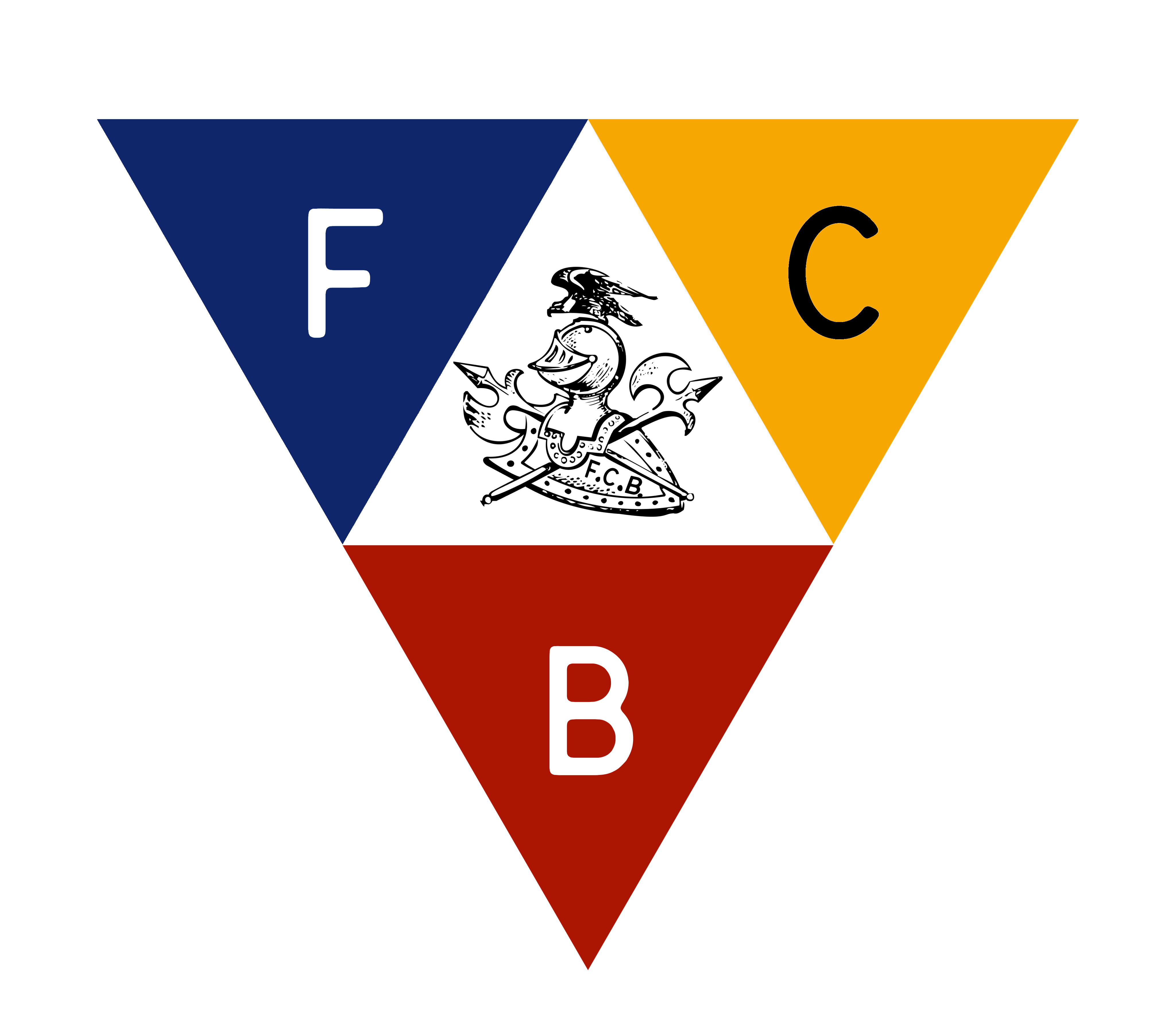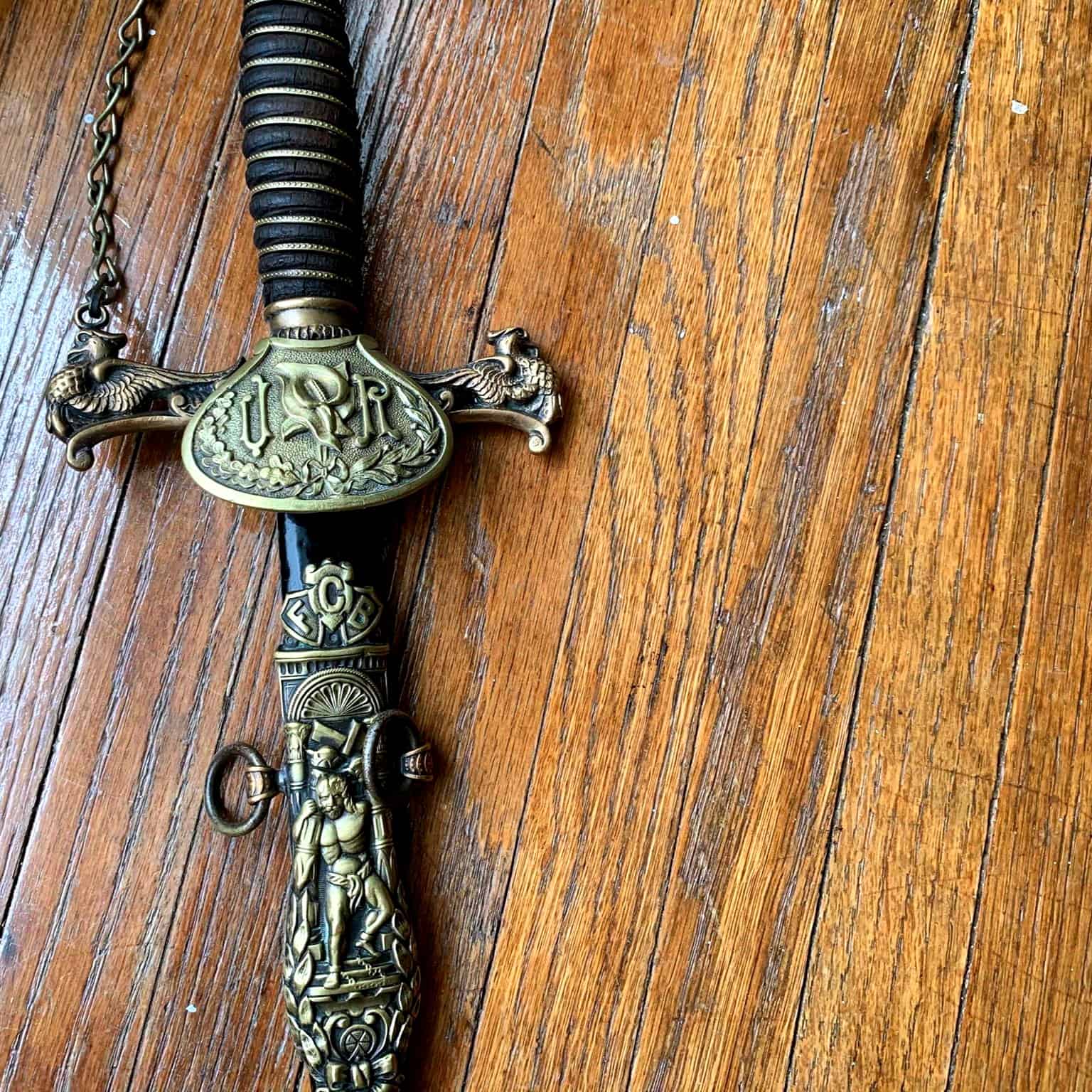A Brief History
Before we explain the markings on your particular sword, let us give you a brief history of the Pythian Order. You will see how it ties in with the various scenes that are usually found on Pythian swords:
The Order Knights of Pythias was founded in Washington DC on February 19, 1864 by Justus H. Rathbone. It is based upon the story of Damon and Pythias, two very close friends during the time of ancient Greek history. Damon was sentenced to death by the tyrant king, Dionysius, and his friend, Pythias, offered to stay as a hostage for four hours so that Damon could visit his family one last time. No one expected Damon to return and face his fate, but at the very last moment, Damon, true to his word and his friend, appeared at the place of execution. The king was so amazed at this show of loyalty and trust that he freed both men. In those days, most men wore helmets, shields, swords, and a variety of weapons. That is why they are so predominant on the swords.
The inscriptions and designs vary. The only requirement is that they meet certain dimensions. The long narrow sword is used for parades and drills because it is easy to handle. The short stubby type is used whenever one has to be placed in a semi-permanent position, such as on the open Bible which is present at all Pythian gatherings. (We are a non-sectarian fraternity but we ask that all members believe in some form of Supreme Being. We do not specify any particular religion or denomination).
The Use of Swords
Swords are still used in our rituals and ceremonies but they are mainly owned by the subordinate lodges. In former times, many Pythians prided themselves in their ability to do “floor work” as we call performing during the rituals and ceremonies. The swords were individually designed and inscribed, and presented as tokens of esteem by friends and family, much as we would now give an inscribed gavel, a plaque or some other expensive gift.
The following markings are those that are commonly found on swords:
The man in the helmet with the lion on top signifies the highest rank (Knighthood). There were three steps to reach full Knighthood – Page, Esquire, and Knight. It is the same in reaching full Knighthood in our fraternity as well. The lion means leadership.
“FCB” stands for FRIENDSHIP, CHARITY, and BENEVOLENCE- the three cardinal principles of the Order to which we adhere very strongly, even today. You will see it wherever Pythianism is mentioned
On some swords, you will see the letters “U R” (not V R) which stand for Uniformed Rank. Just after the fraternity was founded, a very elite group of Pythians fashioned themselves into a militaristic type of organization. They had their own military uniforms, they referred to their lodges as military units, they called themselves by military titles, they went to “encampments” instead of conventions, and they even had their own set of rules and regulations based on that of the U.S. Army. They excelled in marching and in drills and were highly entertaining in parades. The Uniformed Rank used the Lily as its official flora and was known as the “Army of the Lily”, but the Knights use the sprig of myrtle, which signifies eternal friendship. It is placed on the casket of a brother to show that he was loved by his fellow Pythians. The Knights picture a falcon which signifies vigilance, whereas the U R used the dove as its official bird.
The Uniform Rank, Knights of Pythias, grew out of drill corps units that had been organized in the various lodges after the order was originated in1864. Bear in mind that many of the members of the Knights of Pythias were men who had been active in the Civil War and who enjoyed the disciplined way of life. In 1876, under the leadership of James R. Carnahan of Lafayette, IN, there grew a movement to consolidate these various drill corps into a separate but attached organization. In 1878, the Uniform Rank of Knights of Pythias came into legal being by action of the Supreme Lodge. The membership mushroomed. The URKP was organized completely along U.S. Army lines into Companies, Brigades, Regiments, etc.
As the veterans of the Civil War began to pass on, there was a declining interest in the Uniform Rank, and the membership began to quickly drop after the World Wars. In about 1950 one of the last national encampments was held. Shortly after that time, the Supreme Lodge of Knights of Pythias removed the Uniform Rank as an official auxiliary of Pythianism
The child, man and woman in some scenes are Damon and his family saying farewell for the last time. The scene with the man looking out of a building and the group of people exemplifies the site of the execution and the throng that was waiting for the event to start.
The man pulling down the pillars of a building is Samson of the Bible. He is mentioned in our teachings as representing strength.
There are many types of weapons shown on the different swords. The jewels and pendants which our officers wear around their necks or on their lapels during meetings show a particular instrument or weapon or combination thereof, and each officer’s rank is represented by a different symbol. The other decorations and designs have no special significance.
The words “In Esto Perpetua” can be found on some swords. That means “This will be Forever” or words to that effect.
Some swords have the skull and crossbones symbol. That signifies the mortality of man as compared to the immortality of the Supreme Being which most national fraternities ask their prospective members to believe in. We do not specify any particular religion or denomination. We stopped using that symbol many years ago.
In most cases the value of a sword is more sentimental than actual. It is priceless as a family heirloom but not very valuable on the open market. They can be found on the internet for around $50.00 to $150, depending on condition. A brand new one from the factory, with no markings at all, will now cost about $450.00 to $640.00
If you have any further questions about the sword or the Order, please contact us.



I am inquiring some information on a sword that my friend has that was passed down to him by his grandfather on to him and it is an exact sword with the antique of your fraternity
Hello, thank you for your interest! Pythian swords were usually purchased by the family or friends of a Knight as commemorative gifts, often with their name engraved. Many different styles were developed over the course of decades, and there are a wide variety of designs to be found.
I recently picked up a sward at a swap meet. After a bit of digging, I was able to identify it as a Knights of Pythians Uniform Regiment sward and I an just looking for more information on the name engraved on it.. If I am reading this correctly the name engraved is Amen Thomas. Any information is appreciated
I gave one of these swords with a name on it. “Sam Burrell” is that of any interest 🤔?
Thanks so much for this explanation. Now I can look back on my great grandfather’s sword and understand the significance
Hello! I just acquired a sword that someone had found and held on to for 40 years or so. The name Henry Serliman is engraved on the blade. I would like to get this sword back to his family if possible. Would you be able to assist?
How can we find out what chapter or area a family member was in? I have a sword exactly like the photo shown and passed to me from great grandparents.
I recently bought a knight of pythons sword. It’s in very good shape it has the name Joe Pugh. I was wanting to know more about him and the sword and maybe a worth.
Hi, I’m doing some research on a member from the late 1890’s. He’s listed as a “M. of F.” What would those initials mean? Thanks in advance for your help.
I have a Knights of Pythias sword that was handed down through my family. My dad always told me it was his grandfather’s dress sword. The name Heinrich Schneekloth is inscribed in the blade. Is there any way I can learn more about him? He has not shown up in my family tree, etc. Thank you in advance!
I just aquired a sword ingraved w a Carling on the blade. It also has a piece of paper attached with the name Preston Miller 154 1st cavalry. Any info would be helpful. Thank you
I picked up a sword at a Texas Flea Market about 40 years ago. Someone told me it was Knights of Columbus.
Today, I actually saw a KoC Branch and took the sword there. 2 men looked at it and said it was not KoC because of the Samson motif.
I decided to look further and typing FCB Knights brought me here, and I see the Samson motif on one of the swords on your home page.
It has the name Herman or Erman (H isn’t clear) stamped at the base of the Blade.
I used to have it displayed on the wall with several other swords, till a work injury put me in a room at my Brother’s House, and it’s sitting in the closet collecting cigar smoke.
Is there a way to find out how old it is? Or find out who it belonged to? It has an ivory hilt and the Pommel ‘Knights Head’ is somewhat different than the one shown next to the
scabbard I recognize.
I live in Milwaukee Co, WI. Would there be a lodge near me?
Can you help with this one? Has 40 pm back and like suit armor up top. Says fcb , and G D Clark on sword, also UR
I have a sword, I don’t know how old it is or who’s it was. I’m curious about it’s origins
I am researching swords for the Wyoming State Museum. One is described as a Sisters of Pythias sword. Can this be confirmed? Do the Sisters use ceremonial swords?
Thank you.
I have this sword
It was my wife’s grate grandfather”
Edward Day
I could send a picture
I have just came into possession of my grandfather’s sword.. he was from St Louis. I would love to learn more on its specifics. Is there someone who can “interpret” it for me?